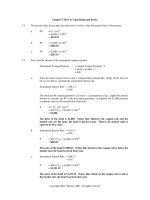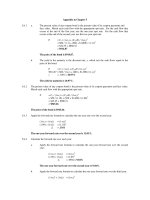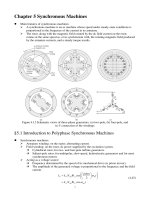Electric commerce chapter 5 b2b e commerce selling and bying in private e markets
Bạn đang xem bản rút gọn của tài liệu. Xem và tải ngay bản đầy đủ của tài liệu tại đây (809.5 KB, 50 trang )
Chapter 5
B2B E-Commerce:
Selling and Buying
in Private E-Markets
Learning Objectives
1. Describe the B2B field.
2. Describe the major types of B2B models.
3. Discuss the characteristics of the sell-side
marketplace, including auctions.
4. Describe the sell-side intermediary models.
5. Describe the characteristics of the buy-side
marketplace and e-procurement.
6. Explain how reverse auctions work in B2B.
Electronic Commerce
Prentice Hall © 2006
2
Learning Objectives
7. Describe B2B aggregation and group purchasing
models.
8. Describe other procurement methods.
9. Explain how B2B administrative tasks can be
automated.
10. Describe infrastructure and standards
requirements for B2B.
11. Describe Web EDI, XML, and Web Services.
Electronic Commerce
Prentice Hall © 2006
3
Concepts, Characteristics,
and Models of B2B EC
•
Basic B2B Concepts
business-to-business e-commerce (B2B EC)
Transactions between businesses conducted
electronically over the Internet, extranets, intranets, or
private networks; also known as eB2B (electronic
B2B) or just B2B
Electronic Commerce
Prentice Hall © 2006
4
Concepts, Characteristics,
and Models of B2B EC
•
Key business drivers for B2B:
–
–
–
–
The availability of a secure broadband Internet
platform and private and public B2B e-marketplaces;
The need for collaborations between suppliers and
buyers;
The ability to save money, reduce delays, and
improve collaboration; and
The emergence of effective technologies for intra- and
interorganizational integration.
Electronic Commerce
Prentice Hall © 2006
5
Exhibit 5.2 Types of B2E EC
Electronic Commerce
Prentice Hall © 2006
6
Concepts, Characteristics,
and Models of B2B EC
•
Basic Types of B2B E-Marketplaces
–
One-to-Many and Many-to-One: Private
E-Marketplaces
company-centric EC
E-commerce that focuses on a single company’s buying
needs (many-to-one, or buy-side) or selling needs (one-tomany, or sell-side)
private e-marketplaces
Markets in which the individual sell-side or buy-side
company has complete control over participation in the
selling or buying transaction
Electronic Commerce
Prentice Hall © 2006
7
Concepts, Characteristics,
and Models of B2B EC
–
Intermediaries are frequently used
•
•
•
–
Conducting auctions
Aggregating buyers
Complex transactions
Many-to-Many: Exchanges
exchanges (trading communities or trading
exchanges)
Many-to-many e-marketplaces, usually owned and run by
a third party or a consortium, in which many buyers and
many sellers meet electronically to trade with each other;
also called trading communities or trading exchanges
Electronic Commerce
Prentice Hall © 2006
8
Concepts, Characteristics,
and Models of B2B EC
–
Many-to-Many: Exchanges
public e-marketplaces
Third-party exchanges that are open to all interested
parties (sellers and buyers)
B2B2C
A business sells to a business, but delivers small
quantities to individuals or business customers
online intermediary
An online third party that brokers a transaction online
between a buyer and a seller; may be virtual or clickand-mortar
Electronic Commerce
Prentice Hall © 2006
9
Concepts, Characteristics,
and Models of B2B EC
–
Types of Transactions
spot buying
The purchase of goods and services as they are
needed, usually at prevailing market prices
strategic systematic sourcing
Purchases involving long-term contracts that usually
are based on private negotiations between sellers and
buyers
Electronic Commerce
Prentice Hall © 2006
10
Concepts, Characteristics,
and Models of B2B EC
–
Types of Materials Traded
direct materials
Materials used in the production of a product (e.g.,
steel in a car or paper in a book)
indirect materials
Materials used to support production (e.g., office
supplies or light bulbs)
MRO (maintenance, repair, and operation)
Indirect materials used in activities that support
production
Electronic Commerce
Prentice Hall © 2006
11
Concepts, Characteristics,
and Models of B2B EC
–
Direction of Trade
vertical marketplaces
Markets that deal with one industry or industry
segment (e.g., steel, chemicals)
horizontal marketplaces
Markets that concentrate on a service, materials, or a
product that is used in all types of industries (e.g.,
office supplies, PCs)
Electronic Commerce
Prentice Hall © 2006
12
Concepts, Characteristics,
and Models of B2B EC
•
Supply Chain Relationships in B2B
–
–
–
B2B private e-marketplace provides a company
with high supply chain power and high capabilities
for online interactions
A public e-marketplace provides a business with
high buying and selling capabilities, but results in
low supply chain power
Using an intermediary results in low supply chain
power and buying/selling capabilities
Electronic Commerce
Prentice Hall © 2006
13
Concepts, Characteristics,
and Models of B2B EC
•
Virtual Services Industries in B2B
–
–
–
–
–
–
Travel and entertainment services
Real estate
Financial services
Online stock trading
Online financing
Other online services
Electronic Commerce
Prentice Hall © 2006
14
Concepts, Characteristics,
and Models of B2B EC
•
Benefits of B2B
–
–
–
–
–
–
–
Creates new sales (purchase) opportunities
Eliminates paper and reduces administrative
costs
Expedites processing and reduces cycle time
Lowers search costs and time for buyers to find
products and vendors
Increases productivity of employees dealing with
buying and/or selling
Reduces errors and improves quality of services
Makes product configuration easier
Electronic Commerce
Prentice Hall © 2006
15
Concepts, Characteristics,
and Models of B2B EC
•
Benefits of B2B (continued)
–
–
–
Reduces marketing and sales costs (for sellers)
Reduces inventory levels and costs
Enables customized online catalogs with different
prices for different customers
– Increases production flexibility, permitting just-intime delivery
– Reduces procurement costs (for buyers)
– Facilitates mass customization
– Provides for efficient customer service
– Increases opportunities
Electronic Commerce
Prentice Hall ©for
2006 collaboration
16
Concepts, Characteristics,
and Models of B2B EC
•
Limitations of B2B
–
–
–
Channel conflict
Operation of public exchanges
Elimination the distributor or the retailer
Electronic Commerce
Prentice Hall © 2006
17
One-to-Many: Sell-Side E-Marketplaces
•
Sell-Side Models and Activities
sell-side e-marketplace
–
A Web-based marketplace in which one company
sells to many business buyers from e-catalogs or
auctions, frequently over an extranet
Three major pricing methods:
1. Selling from electronic catalogs;
2. Selling via forward auctions; and
3. One-to-one selling, usually under a negotiated longterm contract.
Electronic Commerce
Prentice Hall © 2006
18
Exhibit 5.3 Sell-Side B2B
E-Marketplace Architecture
Electronic Commerce
Prentice Hall © 2006
19
One-to-Many: Sell-Side E-Marketplaces
•
Direct Sales from Catalogs
–
–
–
A company usually offers both one catalog for all
customers and a customized catalog for each
large customer
Offers an opportunity for efficient customization
Limitations
•
•
Electronic Commerce
How to contact would-be buyers online
Cost to customer for use of traditional—one solution
is to use extranets
Prentice Hall © 2006
20
Selling via Intermediaries
•
Intermediaries distribute products to a large
number of buyers
–
–
•
Buy products from many vendors and aggregate
them into one catalog from which they sell
Also offer their products online via storefronts
Using Auctions on the Sell-Side
–
–
–
–
Revenue generation
Cost savings
Increased page views
Member acquisition and retention
Electronic Commerce
Prentice Hall © 2006
21
Selling via Intermediaries
•
Selling from the Company’s Own Site
–
•
Large, well-known companies that frequently
conduct auctions, build an auction mechanism on
the company’s own site
Using Intermediaries
–
–
–
No additional resources are required for the
company using the intermediary
Enable a company to have a robust, customized
auction up-and-running immediately
Billing and collection efforts are handled by the
intermediary
Electronic Commerce
Prentice Hall © 2006
22
One-from-Many: Buy-Side
E-Marketplaces and E-Procurement
buy-side e-marketplace
A corporate-based acquisition site that uses reverse
auctions, negotiations, group purchasing, or any
other e-procurement method
Electronic Commerce
Prentice Hall © 2006
23
One-from-Many: Buy-Side
E-Marketplaces and E-Procurement
•
Procurement Methods
–
–
–
–
Conduct bidding or tendering (a reverse auction)
in a system in which suppliers compete against
each other
Buy directly from manufacturers, wholesalers, or
retailers from their catalogs and possibly by
negotiation
Buy from the catalog of an intermediary
(e-distributor) that aggregates sellers’ catalogs
Buy from an internal buyer’s catalog, in which
company-approved vendors’ catalogs, including
agreed-upon prices, are aggregated
Electronic Commerce
Prentice Hall © 2006
24
One-from-Many: Buy-Side
E-Marketplaces and E-Procurement
–
–
–
–
Buy at private or public auction sites in which the
organization participates as one of the buyers
Join a group-purchasing system that aggregates
participants’ demand, creating a large volume
Buy at an exchange or industrial mall
Collaborate with suppliers to share information
about sales and inventory, so as to reduce
inventory and stock-outs and enhance just-in-time
delivery
Electronic Commerce
Prentice Hall © 2006
25









